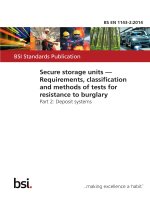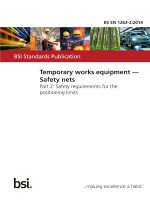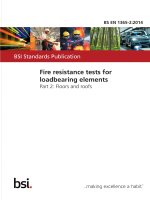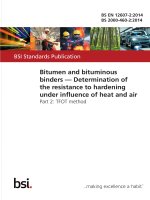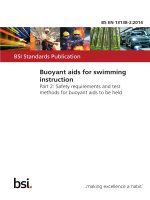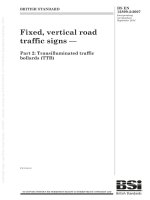Bsi bs en 61300 2 43 2014
Bạn đang xem bản rút gọn của tài liệu. Xem và tải ngay bản đầy đủ của tài liệu tại đây (1.18 MB, 18 trang )
BS EN 61300-2-43:2014
BSI Standards Publication
Fibre optic interconnecting
devices and passive
components — Basic test
and measurement
procedures
Part 2-43: Tests — Screen testing of
return loss of single-mode PC optical
fibre connectors
BRITISH STANDARD
BS EN 61300-2-43:2014
National foreword
This British Standard is the UK implementation of EN 61300-2-43:2014. It is
identical to IEC 61300-2-43:2014. It supersedes BS EN 61300-2-43:2000
which is withdrawn.
The UK participation in its preparation was entrusted by Technical
Committee GEL/86, Fibre optics, to Subcommittee GEL/86/2, Fibre optic
interconnecting devices and passive components.
A list of organizations represented on this committee can be obtained on
request to its secretary.
This publication does not purport to include all the necessary provisions of
a contract. Users are responsible for its correct application.
© The British Standards Institution 2014.
Published by BSI Standards Limited 2014
ISBN 978 0 580 80875 3
ICS 33.180.20
Compliance with a British Standard cannot confer immunity from
legal obligations.
This British Standard was published under the authority of the
Standards Policy and Strategy Committee on 30 September 2014.
Amendments/corrigenda issued since publication
Date
Text affected
EUROPEAN STANDARD
EN 61300-2-43
NORME EUROPÉENNE
EUROPÄISCHE NORM
September 2014
ICS 33.180.20
Supersedes EN 61300-2-43:1999
English Version
Fibre optic interconnecting devices and passive components Basic test and measurement procedures - Part 2-43: Tests Screen testing of return loss of single-mode PC optical fibre
connectors
(IEC 61300-2-43:2014)
Dispositifs d'interconnexion et composants passifs à fibres
optiques - Procédures fondamentales d'essais et de
mesures - Partie 2-43: Essais - Sélection des connecteurs
PC pour fibres optiques unimodales en fonction de leur
affaiblissement de réflexion
(CEI 61300-2-43:2014)
Lichtwellenleiter - Verbindungselemente und passive
Bauteile -Grundlegende Prüf- und Messverfahren Teil 2-43: Prüfungen - Verfahren zur Sortierprüfung von
Einmoden-PC-LWL-Steckverbindern in Abhängigkeit von
der Rückflussdämpfung
(IEC 61300-2-43:2014)
This European Standard was approved by CENELEC on 2014-07-24. CENELEC members are bound to comply with the CEN/CENELEC
Internal Regulations which stipulate the conditions for giving this European Standard the status of a national standard without any alteration.
Up-to-date lists and bibliographical references concerning such national standards may be obtained on application to the CEN-CENELEC
Management Centre or to any CENELEC member.
This European Standard exists in three official versions (English, French, German). A version in any other language made by translation
under the responsibility of a CENELEC member into its own language and notified to the CEN-CENELEC Management Centre has the
same status as the official versions.
CENELEC members are the national electrotechnical committees of Austria, Belgium, Bulgaria, Croatia, Cyprus, the Czech Republic,
Denmark, Estonia, Finland, Former Yugoslav Republic of Macedonia, France, Germany, Greece, Hungary, Iceland, Ireland, Italy, Latvia,
Lithuania, Luxembourg, Malta, the Netherlands, Norway, Poland, Portugal, Romania, Slovakia, Slovenia, Spain, Sweden, Switzerland,
Turkey and the United Kingdom.
European Committee for Electrotechnical Standardization
Comité Européen de Normalisation Electrotechnique
Europäisches Komitee für Elektrotechnische Normung
CEN-CENELEC Management Centre: Avenue Marnix 17, B-1000 Brussels
© 2014 CENELEC All rights of exploitation in any form and by any means reserved worldwide for CENELEC Members.
Ref. No. EN 61300-2-43:2014 E
BS EN 61300-2-43:2014
EN 61300-2-43:2014
-2-
Foreword
The text of document 86B/3669/CDV, future edition 2 of IEC 61300-2-43, prepared by SC 86B "Fibre
optic interconnecting devices and passive components" of IEC/TC 86 "Fibre optics" was submitted to
the IEC-CENELEC parallel vote and approved by CENELEC as EN 61300-2-43:2014.
The following dates are fixed:
–
latest date by which the document has to be implemented at
national level by publication of an identical national
standard or by endorsement
(dop)
2015-04-24
–
latest date by which the national standards conflicting with
the document have to be withdrawn
(dow)
2015-07-24
This document supersedes EN 61300-2-43:1999.
Attention is drawn to the possibility that some of the elements of this document may be the subject of
patent rights. CENELEC [and/or CEN] shall not be held responsible for identifying any or all such
patent rights.
Endorsement notice
The text of the International Standard IEC 61300-2-43:2014 was approved by CENELEC as a
European Standard without any modification.
In the official version, for Bibliography, the following note has to be added for the standard indicated :
IEC 61300-1
NOTE
Harmonized as EN 61300-1.
-3-
BS EN 61300-2-43:2014
EN 61300-2-43:2014
Annex ZA
(normative)
Normative references to international publications
with their corresponding European publications
The following documents, in whole or in part, are normatively referenced in this document and are
indispensable for its application. For dated references, only the edition cited applies. For undated
references, the latest edition of the referenced document (including any amendments) applies.
NOTE 1
When an International Publication has been modified by common modifications, indicated by (mod),
the relevant EN/HD applies.
NOTE 2
Up-to-date information on the latest versions of the European Standards listed in this annex is
available here: www.cenelec.eu.
Publication
Year
Title
EN/HD
Year
IEC 61300-3-6
-
Fibre optic interconnecting devices and
passive components - Basic test and
measurement procedures Part 3-6: Examinations and
measurements - Return loss
EN 61300-3-6
-
–2–
BS EN 61300-2-43:2014
IEC 61300-2-43:2014 © IEC 2014
CONTENTS
1
Scope .............................................................................................................................. 5
2
Normative references ...................................................................................................... 5
3
General description ......................................................................................................... 5
4
Apparatus ........................................................................................................................ 5
5
Procedure ........................................................................................................................ 6
5.1
Selection of the reflection standard cord ................................................................. 6
5.2
Cord screen testing ................................................................................................. 6
5.3
Pigtail cord screen testing ....................................................................................... 6
6
Details to be specified ..................................................................................................... 7
Annex A (informative) Screen testing of return loss of pigtails having PC fibre optic
connector ................................................................................................................................ 8
Bibliography .......................................................................................................................... 13
Figure 1 – Measurement set-up for open plug reflection standard ........................................... 6
Figure 2 – Measurement set-up for mated reflection standard cords ....................................... 6
Figure 3 – Measurement set-up for cord screen testing ........................................................... 6
Figure 4 – Measurement set-up for pigtail cord screen testing ................................................ 7
Figure A.1 – Measurement set-up of the screen test method ................................................... 9
Figure A.2 – Relationship between ß and α ........................................................................... 10
Figure A.3 – Cumulative probability of return loss before test ................................................ 11
Figure A.4 – Cumulative probability of return loss after test .................................................. 11
Figure A.5 – Relationship between power and α ................................................................... 12
Figure A.6 – Measurement set-up of the reflected powers ..................................................... 12
BS EN 61300-2-43:2014
IEC 61300-2-43:2014 © IEC 2014
–5–
FIBRE OPTIC INTERCONNECTING DEVICES
AND PASSIVE COMPONENTS –
BASIC TEST AND MEASUREMENT PROCEDURES –
Part 2-43: Tests – Screen testing of return loss of
single-mode PC optical fibre connectors
1
Scope
This part of IEC 61300 aims at screening single-mode physical contact (PC) optical fibre
connectors of an optical fibre cord or an optical fibre pigtail in terms of return loss, thus
ensuring minimum return loss when the connectors, which have been screen tested by this
method, are randomly mated with each other in the field.
2
Normative references
The following documents, in whole or in part, are normatively referenced in this document and
are indispensable for its application. For dated references, only the edition cited applies. For
undated references, the latest edition of the referenced document (including any
amendments) applies.
IEC 61300-3-6, Fibre optic interconnecting devices and passive components – Basic test and
measurement procedures – Part 3-6: Examinations and measurements – Return loss
3
General description
The domed ferrule end faces of PC connectors (not angled) are produced by a polishing
process. This polishing process results in a thin damaged layer at the fibre end face of the
connector. In silica fibres, the refractive index of the damaged layer is slightly higher than that
of original fibre. This high refractive index layer generates optical reflection. When PC
connectors are mated, return loss occurs as a result of multiple reflections at the two
damaged layers of the butted connectors.
This test procedure ensures that a designed minimum return loss is achieved when PC
connectors are randomly mated. It screens cords or pigtails by using a pair of reflection
standard plug (RP) cords. The pair of reflection standard plugs is selected on the condition
that the return loss when the plugs are mated is several decibels better than the designed
minimum return loss. Cords which pass this test will achieve the designed minimum return
loss in over 99 % of cases when randomly mated (see Annex A).
4
Apparatus
The equipment listed below shall be chosen according to the method used to measure the
connector return loss, in accordance with IEC 61300-3-6. The reflection standard plug shall
be prepared according to the procedure given in 5.1.
•
Sources S
•
Excitation unit E
•
Detector D
•
Temporary joint TJ
•
Terminator T
•
Branching device BD
•
Reflection standard cord
BS EN 61300-2-43:2014
IEC 61300-2-43:2014 © IEC 2014
–6–
The reflection standard cord has a reflection standard plug (RP) at one end. The other end of
the reflection standard cord is an end or a plug whose return loss is better than the designed
minimum return loss L rs (in decibels).
5
5.1
Procedure
Selection of the reflection standard cord
The reflection standard plug (RP) shall be selected by the following procedure.
a) Set up an objective reflection standard cord as shown in Figure 1.
S
E
TJ
BD
RP
D
14,7 dB
IEC
2022/14
Figure 1 – Measurement set-up for open plug reflection standard
b) Set the detector to 14,7 dB as the Fresnel reflection between the air and the silica fibre
core as shown in Figure 1. The refractive index of air is 1,0, and the one of silica fibre is
1,452 for single-mode fibre on condition ∆ = 0,3 %, λ = 1,31 µm.
NOTE Measurement accuracy can be improved by using the actual parameters of fibres which have been
employed.
c) Connect another objective reflection standard cord as shown in Figure 2, then measure
the return loss.
S
E
TJ
BD
TT
RP
D
RP
RP
L rs + β (in decibels)
IEC
2023/14
Figure 2 – Measurement set-up for mated reflection standard cords
d) Take the pair of objective reflection standard cords as reflection standard cords on
condition that their return loss from the mating point is L rs + β (in decibels), where L rs is a
designed minimum return loss. The value of β shall be set at above 2 dB.
5.2
Cord screen testing
a) Connect the device under test (DUT) (cord) between the reflection standard plugs as
shown in Figure 3.
TJ
S
E
BD
DUT
RP
D
TT
RP
L r (in decibels)
IEC
2024/14
Figure 3 – Measurement set-up for cord screen testing
b) Measure the return loss L r (in decibels) from the two PC mating points.
c) Consider the objective cord as a screen tested cord when L r is greater than L rs .
5.3
Pigtail cord screen testing
a) Connect the objective PC connector of DUT (pigtail cord) to one reflection standard plug
as shown in Figure 4, and terminate pigtail fibre end.
BS EN 61300-2-43:2014
IEC 61300-2-43:2014 © IEC 2014
S
E
–7–
BD
TJ
DUT
TT
RP
D
L rs + α (in decibels)
IEC
2025/14
Figure 4 – Measurement set-up for pigtail cord screen testing
b) Measure the return loss L r (in decibels) from the mating point.
c) Pass the objective pigtail cord as a screen tested cord when L r is greater than L rs + α (in
decibels). The value of α shall be set at above 0,6 dB and at less than 5 dB.
6
Details to be specified
The following details, as applicable, shall be specified in the relevant specification:
–
minimum return loss L rs (in decibels);
–
condition of standard reflection plugs (the value of β in decibels);
–
screening condition for pigtail cords (the value of α in decibels);
–
attenuation of mating points between the reflection standard connectors and the objective
connectors;
–
measurement uncertainty.
–8–
BS EN 61300-2-43:2014
IEC 61300-2-43:2014 © IEC 2014
Annex A
(informative)
Screen testing of return loss of pigtails
having PC fibre optic connector
This annex describes the theoretical background of the screen testing of return loss for
pigtails. The basic idea is the same as the screen testing of return loss of cords having PC
fibre optic connectors: select a pair of reference connectors, and a measurement pigtail is
screen tested using the reference connector under a condition which is determined by
simulation, where the distribution of high refractive index layer caused by polishing process is
considered.
Two parameters β and α are introduced into this method. Parameter β is used for the
selection of a pair of reference connectors. Parameter α is used as a criterion for screen
testing measurement connectors. These two parameters β and α are carefully determined by
simulation so that return loss of mating point exceeds certain specified return loss L rs with
high probability when the screen tested connectors are randomly connected.
The method assumes:
–
refractive index of fibre core n 1 is 1,452;
–
refractive index of air n 2 is 1,0.
The set-up of the measurement and test procedures will be shown first. Figure A.1 shows the
set-up with the reference cords 1 and 2; 1a and 2a represent reference connectors. Points 3a
and 3b are the connectors of the cord under test and 4a is the connector of the pigtail under
test. The connectors represented by 1b and 2b and 5b are angled connectors with high return
loss. S is the optical source, D is the optical detector and BD represents the optical coupler. T
is a fibre termination which shall have a high return loss; it should be made by the application
of an index matching material to the fibre end or introducing an high attenuation in the fibre,
for example, with a mandrel wrap.
BS EN 61300-2-43:2014
IEC 61300-2-43:2014 © IEC 2014
–9–
P0
S
BD
5b
1
Reference cord 1
1a
1b
P8
D
Reference cord 1
Adapter
2
Reference cord 2
2a
2b
P1
Adapter
3
Reference cord 1
Adapter
Cord under test
3a
Reference cord 2
3b
2a
P2
Adapter
Reference cord 1
4
Pigtail under test
T
4a
P3
IEC
2026/14
Figure A.1 – Measurement set-up of the screen test method
P0 is the input power and P8, P1, P2 and P3 are the reflected powers. The symbols , , ,
indicate connection conditions.
The procedure of the screen test method is as follows:
a) A pair of reference plugs is selected.
–
Connect the connector 1b to the connector 5b, then measure the power P8 (see in
Figure A.1).
–
Connect the reference connector 2a to the reference connector 1a, then measure the
power P1 (see in Figure A.1).
The condition of selection is given by:
L rs < –10 log P1/P0 ≤ L rs + β (dB)
(A.1)
The measured power P0 can be described using P8, n 1 and n 2 as follows:
–10 log 1/P0 = –10 log 1/P8 – 20 log (n 1 – n 2 ) / (n 1 + n 2 )
(A.2)
The second term of the right side represents Fresnel reflection of air, and equals 14,7 dB.
Therefore Equation (A.1) can be rewritten as:
0 < –10 log P1/P8 + 14,7 – L rs ≤ β
(A.3)
b) The cord under test is screen tested using the pair of reference connectors.
–
Connect the cord under test 3 between the reference connectors 1a and 2a, then
measure the power P2 (see in Figure A.1).
BS EN 61300-2-43:2014
IEC 61300-2-43:2014 © IEC 2014
– 10 –
The criteria for the screen test of the measurement connectors are given by:
–10 log P2/P8 + 14,7 ≥ L rs + α (dB)
(A.4)
c) The pigtail under test is screen tested using one of the pair reference connectors.
–
Remove the reference connector 2a from reference connector 1a.
–
Connect measurement connector 4a to the reference connector 1a, then measure the
power P3 (see in Figure A.1).
The criteria for the screen test of the measurement connectors is given by:
–10 log P3/P8 + 14,7 ≥ L rs + α (dB)
(A.5)
The parameters β and α are determined by simulation so that the return loss of mating point
exceeds the specified return loss L rs with high probability when the screen tested connectors
are randomly connected.
Figure A.2 shows the relation between β and α derived by the condition that the return loss at
the mating point exceeds a specified value L rs with a probability of 99 %. The white circles
represent the simulation results for pigtails. The black circles represent those for cords. The
lines indicate first-order regression lines. The figure indicates that the return loss of randomly
concatenated cords exceeds L rs (in decibels) with a probability of 99 % under the condition of
α ≥ 0,4 β – 2,0. The parameters β and α shall be determined according to this condition.
4
α (dB)
2
α = 0,45 β − 0,3
0
Cord
−2
Pigtail
α = 0,4 β − 2,0
−4
−4
−2
0
2
4
6
β (dB)
IEC
2027/14
Figure A.2 – Relationship between ß and α
Figure A.3 shows the cumulative probability of return loss before screen testing. Figure A.4
shows the cumulative probability of return loss when pigtails were screen tested under the
condition of Equation (A.5) using the reference cord selected in accordance with Equation
(A.1). The parameters L rs , β and α are set at 45 dB, 5 dB and 2 dB, respectively. For pigtails,
the probability exceeds 99 % when the return loss L rs is greater than 45 dB.
BS EN 61300-2-43:2014
IEC 61300-2-43:2014 © IEC 2014
– 11 –
Cumulative probability
(%)
100
1
1
0,1
35
40
45
50
55
Return loss
60
65
(dB)
IEC
2028/14
Figure A.3 – Cumulative probability of return loss before test
Cumulative probability
(%)
100
β = 5, α = 2
1
1
35
40
45
50
Return loss
55
60
65
(dB)
IEC
2029/14
Figure A.4 – Cumulative probability of return loss after test
It is also important for the screen testing of pigtails that the fibre surface condition of one of
the paired reference connectors is almost equal to that of the other reference connector.
Figure A.5 shows the relation of the difference of P4 and P5 and difference of α a and α b . P4
and P5 are the reflected power of the paired reference connectors. The power is measured in
the way described in Figure A.6 where the meaning of the symbols is the same as in
Figure A.1. The parameters α a and α b are individual criteria which mean that the return loss
of randomly concatenated connectors selected using the individual reference connector
exceeds a specified value L rs with a probability of 99 % under following condition:
–10 log P2/P8 + 14,7 ≥ L rs + α a (dB); or
–10 log P2/P8 + 14,7 ≥ L rs + α b (dB).
Figure A.5 shows that the fibre surface condition of the reference connector 1a is almost
equal to that of the reference connector 2a when the difference between the measured power
P4 and P5 is small. The power P4 and P5 shall satisfy the following condition to obtain the
small difference between α a and α b within 1,0 dB:
2,0 (dB) ≥ | –10 log P4/P5 |
(A.6)
BS EN 61300-2-43:2014
IEC 61300-2-43:2014 © IEC 2014
– 12 –
α a − α b (dB)
6
4
2
0
0
5
10
−10 log
15
P4
P5
20
(dB)
IEC
2030/14
Figure A.5 – Relationship between power and α
Reference cord 1
S
BD
5b
1
T
1b
1a
P4
D
Reference cord 2
2
T
2b
2a
P5
Reference cord 1
Adapter
Pigtail under test
3
T
4a
P2
Reference cord 2
Adapter
Pigtail under test
4
T
4a
P2
IEC
2031/14
Figure A.6 – Measurement set-up of the reflected powers
BS EN 61300-2-43:2014
IEC 61300-2-43:2014 © IEC 2014
– 13 –
Bibliography
IEC 61300-1, Fibre optic interconnecting devices and passive components – Basic test and
measurement procedures – Part 1: General and guidance
_____________
This page deliberately left blank
This page deliberately left blank
NO COPYING WITHOUT BSI PERMISSION EXCEPT AS PERMITTED BY COPYRIGHT LAW
British Standards Institution (BSI)
BSI is the national body responsible for preparing British Standards and other
standards-related publications, information and services.
BSI is incorporated by Royal Charter. British Standards and other standardization
products are published by BSI Standards Limited.
About us
Revisions
We bring together business, industry, government, consumers, innovators
and others to shape their combined experience and expertise into standards
-based solutions.
Our British Standards and other publications are updated by amendment or revision.
The knowledge embodied in our standards has been carefully assembled in
a dependable format and refined through our open consultation process.
Organizations of all sizes and across all sectors choose standards to help
them achieve their goals.
Information on standards
We can provide you with the knowledge that your organization needs
to succeed. Find out more about British Standards by visiting our website at
bsigroup.com/standards or contacting our Customer Services team or
Knowledge Centre.
Buying standards
You can buy and download PDF versions of BSI publications, including British
and adopted European and international standards, through our website at
bsigroup.com/shop, where hard copies can also be purchased.
If you need international and foreign standards from other Standards Development
Organizations, hard copies can be ordered from our Customer Services team.
Subscriptions
Our range of subscription services are designed to make using standards
easier for you. For further information on our subscription products go to
bsigroup.com/subscriptions.
With British Standards Online (BSOL) you’ll have instant access to over 55,000
British and adopted European and international standards from your desktop.
It’s available 24/7 and is refreshed daily so you’ll always be up to date.
You can keep in touch with standards developments and receive substantial
discounts on the purchase price of standards, both in single copy and subscription
format, by becoming a BSI Subscribing Member.
PLUS is an updating service exclusive to BSI Subscribing Members. You will
automatically receive the latest hard copy of your standards when they’re
revised or replaced.
To find out more about becoming a BSI Subscribing Member and the benefits
of membership, please visit bsigroup.com/shop.
With a Multi-User Network Licence (MUNL) you are able to host standards
publications on your intranet. Licences can cover as few or as many users as you
wish. With updates supplied as soon as they’re available, you can be sure your
documentation is current. For further information, email
BSI Group Headquarters
389 Chiswick High Road London W4 4AL UK
We continually improve the quality of our products and services to benefit your
business. If you find an inaccuracy or ambiguity within a British Standard or other
BSI publication please inform the Knowledge Centre.
Copyright
All the data, software and documentation set out in all British Standards and
other BSI publications are the property of and copyrighted by BSI, or some person
or entity that owns copyright in the information used (such as the international
standardization bodies) and has formally licensed such information to BSI for
commercial publication and use. Except as permitted under the Copyright, Designs
and Patents Act 1988 no extract may be reproduced, stored in a retrieval system
or transmitted in any form or by any means – electronic, photocopying, recording
or otherwise – without prior written permission from BSI. Details and advice can
be obtained from the Copyright & Licensing Department.
Useful Contacts:
Customer Services
Tel: +44 845 086 9001
Email (orders):
Email (enquiries):
Subscriptions
Tel: +44 845 086 9001
Email:
Knowledge Centre
Tel: +44 20 8996 7004
Email:
Copyright & Licensing
Tel: +44 20 8996 7070
Email:

